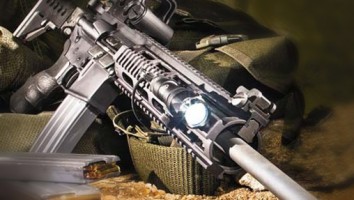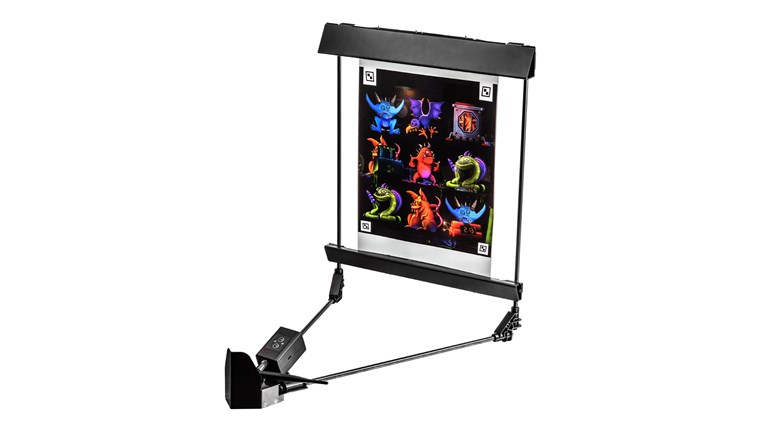
Having more than four decades of U.S. military service under its belt, the M16 is practically a tradition in this country. However, despite the popularity of our nation's service rifle and its semi-auto AR-15 cousin, there have been longstanding criticisms of their design.
Critics often focus on two elements of the platform. First and foremost, detractors find fault with the direct gas-impingement system (DGIS) of operation that dumps fouling directly into the action. To a lesser degree, they take issue with the in-line stock system that employs a buffer assembly extending into the stock.
Although neither of these characteristics are much of an issue in standard rifle-length ARs, both become points of contention when the gun is downsized to its carbine-sized variant. At the same time, the ever-increasing popularity of the M4-style carbine exacerbates these shortcomings.
In regard to the DGIS, shortening the barrel and gas system to create a carbine results in the action opening much quicker than in a rifle-length AR. This leads to higher chamber pressures during cycling, and hotter gas and fouling jetting into the action.
The in-line stock and buffer assembly create other issues in carbines. Although the in-line design has many positive attributes—namely reduced muzzle rise due to the straight-back path of recoil and the generous amount of bolt overtravel the system allows—it prevents a true folding stock from being employed because the lengthy bolt carrier is designed to cycle rearward into the buttstock assembly. As a result, although appealing in their size, power and portability, traditional AR carbines are not as compact as some would hope.
In the past few years there has been a growing effort to address the concerns about the AR's DGIS—most specifically through adapting the design to a piston system. However, the changes add parts to the design, often increase the gun's weight and usually do nothing to address the issue of the action opening more quickly due to the shortened gas system. Neither do they answer the concerns over the inability of an AR design to accept a folding stock.
A Surprising Source
Maybe it was time for someone to take a look at the AR carbine as a whole, rather than just one aspect of it. Enter the genre-redefining Para USA Tactical Target Rifle (TTR), an AR-pattern rifle chambered for 5.56 NATO that offers shooters an intriguing solution to not only the gas-system issue, but also the folding-stock conundrum.
Yes, you read that right. Para's new AR. Para USA, a company well known for its extensive line of handgun offerings, has a hard-earned reputation for innovative firearms such as its LDA and double-column, extended-capacity 1911s. However, the TTR represents the company's first move into the long-gun realm.
In fact, the TTR is the result of a collaboration between Para and Z-M Weapons. Based on Z-M's LR series of ARs, the TTR is being produced in Para's new manufacturing facility in Charlotte, NC.
At first glance, the TTR appears to be a relatively traditional AR-pattern rifle, at least by today's Picatinny-rail obsessed standards. In fact, I almost unfairly overlooked the new TTR at the 2009 SHOT Show. As I was passing by Para's booth, rushing to a scheduled meeting, I spotted it on a rack and thought, "Hmmm. A Para AR? Well, why not? Everybody else is making one."
However, my better judgment took hold, and I gave it a closer look. It was then that I recognized there was a bit more to the TTR than the run-of-the-mill ARs littering the show. Specifically, I noticed the buttstock appeared to be capable of folding, along with being adjustable for length of pull. That change at the very least required removing the buffer tube assembly and relocating the recoil-spring assembly.
I couldn't help but wonder what other interesting things were going on inside the TTR, as I was aware of what would be involved in redesigning the AR to employ a stock of this sort. As I examined the rifle more closely, I ultimately missed my meeting.
DIGS It
Proudly emblazoned above the display rifle was a simple acronym—DIGS. Recognizing this is very similar to DGIS, I surmised the TTR's gas system had been redesigned.
At this point, I made my second faulty assumption about the TTR. My initial thought was it probably featured a piston system of operation as is all the rage these days. However, after talking to Kerby Smith, Para's director of communications, I began to realize the TTR is truly unique.
Smith told me, "DIGS stands for 'delayed-impingement gas system.' It does not have a piston, but instead has a redesigned impingement system." When I expressed interest in finding out more details, Smith brought Allan Zitta from Z-M Weapons over to talk to me.
"Take a look at the gas block of the TTR," Zitta suggested. Upon close examination, I realized it was notably long—about 31⁄2 inches in overall length. "That is the DIGS," he said. Zitta went on to explain the system involves a lengthened gas block with a forward-directed, U-shaped gas channel inside.
This unique design channels gas forward, up, around and then back toward the action, resulting in a subtle but significant increase in the time it that it takes the gas to move through the system. The result is a gas system with the overall length of one found in a shortened carbine, but with a cycling time similar to the longer gas system found on a 20-inch-barreled rifle.
Time to Vent
The U-shaped gas channel is not the only unique element of the TTR's operating system. On a traditional AR, gas flows through a gas tube, impacting a gas key on the top of the bolt carrier at the end of the tube. Once gas pushes the key and bolt carrier rearward, the remaining gas dumps directly into the action.
Not so with the TTR. Employing what Para has dubbed the Manifold Injector System (MIS), the TTR vents gas through the system and out of the rifle during cycling. Rather than employing a traditional short gas key, the TTR's bolt carrier has an operation rod measuring 111⁄4 inches in length and occupying nearly 7 inches of the fore-end when the action is closed.
The op rod, which slides over the TTR's roughly 41⁄2-inch gas tube, contains gas during cycling and prevents it from flowing directly into the action. As gas is channeled through the op rod, it then vents down into the bolt carrier. The design allows gas to be diverted through the bolt carrier and out the ejection port through extra ports bored into the carrier's side. The result is a system that should run cooler and cleaner than a comparable DGIS-driven AR.
Short Change
Once Zitta explained the nuances of the DIGS operation, I had some questions about the folding buttstock. I knew a traditional AR's lengthy bolt carrier extends back into the buffer-tube assembly in the stock during cycling, so employing a folding stock for the TTR would require a radically shortened bolt carrier.
"Yes, it does," Zitta told me. "The TTR's bolt carrier itself is only about 4 inches long, with the rear portion removed." However, he pointed out that the bolt carrier is still long enough to employ the notches on its side to work with a forward-assist unit.
Although a truncated bolt carrier adequately explained how the TTR could dispense with a buffer tube in the buttstock assembly, I was still curious about where the recoil spring assembly was located in the TTR.
By pushing down on a spring-loaded plunger located on top and near the front of the fore-end, Zitta demonstrated the top rail section can be removed to expose the rifle's gas system. Once this piece was separated, he explained the TTR's recoil spring is located above the barrel, wrapping around the lengthy op rod.
Removing the top rail is part of the disassembly procedure for the TTR, according to Zitta. With it detached, you can retract the recoil spring by removing a retainer clip. The action can then be broken open, and the bolt-carrier assembly and op rod can be retracted from the upper receiver.
Zitta demonstrated the process, which allowed me to examine the bolt-carrier assembly and the op rod. It also gave me an opportunity to inspect the TTR's charging handle, which appeared much beefier than that found on a standard AR.
"To work with this system, the TTR's charging handle is built more sturdily than a standard unit," Zitta said. "It has a channel in it that vents any excess gas in the system out and to the right of the handle's rear." He also explained the upper receiver assembly is a proprietary unit, taller and sturdier in its upper rail portion than a standard AR upper to accommodate the MIS and the strengthened charging handle.
Folder to Fore-End
The buttstock assembly of the TTR—the feature that first drew my attention to the rifle—is a Para USA unit dubbed the Rapid Deployment Stock (RDS). A side-folding stock, the RDS features five length-of-pull positions. Adjustments are accomplished by squeezing on a paddle-shaped lever in the lower face of the stock.
Simply pull up on the body of the stock against spring tension to free it from the locking block, and fold it alongside the rifle. The RDS can fold while set to any length of pull, and the spring tension from the locking-block mechanism holds it in the folded position. When folded, the stock blocks the bolt-release lever, but not the safety. Returning the stock to the extended position is as easy as swinging it back into contact with the locking block.
The TTR is offered in four variants. Three versions feature the RDS folding stock, each with a different fore-end. The TTR-XA has a fore-end with four full-length Picatinny rails; the TTR-XAS sports an aluminum fore-end with partial strips of Picatinny rail; and the TTR-NX features a Nylatron synthetic fore-end. Lastly, the TTR-XASF has the partial rail fore-end with a fixed stock.
The TTR 's upper and lower receivers are 7075-T6 aluminum and are machined from forgings. The 161⁄2-inch barrel is chrome lined and rate-of-twist is 1:9 inches. It ends with a Para USA Phantom flash suppressor and does not feature an M4 barrel contour.
Rather than a standard A2-style pistol grip, the TTR comes with a Command Arms Accessories G-27 grip with finger grooves, contoured backstrap and storage compartment. Finally, the TTR employs standard, readily available STANAG magazines.
Range Time
I recently had the opportunity to test a TTR for myself, in particular the TTR-XAS variant. When I received the rifle, I was extremely impressed by its fit and finish. The aluminum parts were anodized a deep black, while the steel parts featured a dark-gray, phosphated finish.
The stock folded and unfolded easily, and it was rock solid in the extended position. Adjusting the length of pull also proved to be easy. All controls functioned smoothly. Despite the radical nature of its internal operation, the TTR should be familiar to anyone who has used an AR-style rifle. However, it was very apparent when manually cycling the action that I was pulling against a spring above the barrel rather than pushing against one in the buttstock.
As I needed to fit the rifle with optics for testing, I decided to use this opportunity to try some new offerings from EOTech. In particular, the XPS2-0 holographic weapon sight and the G23.FTS magnifier unit.
The XPS2-0 is the company's smallest sight yet, employing a single-transverse CR123 battery, and the G23.FTS is the second generation of EOTech's magnifier units. It features a flip-to-side mount, and internal windage and elevation adjustments.
Once I had the TTR fitted with an optic, I headed out to the range to test the gun with a selection of Black Hills, Federal and Winchester loads. Over the course of a few hundred rounds, I did not experience a single malfunction. The single-stage trigger broke cleanly and crisply. Groups of less than 2 inches were common, with the TTR showing a preference for the lightest, Federal TNT 43-grain load.
During testing, the TTR had a very pleasant recoil impulse, even by the light-recoiling standards of the AR. I also noticed the front end of the aluminum fore-end—where it comes into contact with the gas block—heated up very quickly. The bolt-release lever on the left side of the receiver required more force to activate than I recall with other AR-style rifles.
The TTR from Para USA represents a noteworthy approach to the issues created by downsizing the AR. By developing a novel solution to the points of contention at both the front and rear of the platform, the company has proven yet again that it remains a go-to source for innovative firearm offerings.





































